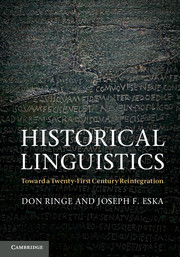Book contents
- Frontmatter
- Contents
- Figures
- Tables
- Preface
- Acknowledgments
- Introduction
- 1 The nature of human language and language variation
- 2 Language replication and language change
- 3 Language change in the speech community
- 4 Language contact as a source of change
- 5 Sound change
- 6 The evolution of phonological rules
- 7 Morphology
- 8 Morphological change
- 9 Syntactic change
- 10 Reconstruction
- 11 Beyond comparative reconstruction
- Appendix: Recovering the pronunciation of dead languages: types of evidence
- References
- General index
- Index of languages and families
10 - Reconstruction
Published online by Cambridge University Press: 05 February 2013
- Frontmatter
- Contents
- Figures
- Tables
- Preface
- Acknowledgments
- Introduction
- 1 The nature of human language and language variation
- 2 Language replication and language change
- 3 Language change in the speech community
- 4 Language contact as a source of change
- 5 Sound change
- 6 The evolution of phonological rules
- 7 Morphology
- 8 Morphological change
- 9 Syntactic change
- 10 Reconstruction
- 11 Beyond comparative reconstruction
- Appendix: Recovering the pronunciation of dead languages: types of evidence
- References
- General index
- Index of languages and families
Summary
In Chapter 5 we noted that a sound change which has “gone to completion” might become a phonological rule, or that its outcome might be projected into underlying forms. The former, which we discussed at length in Chapter 6, is of interest to linguists studying phonological systems. Instances in which sound changes alter underlying forms are important for a completely different reason. In those cases the effects of regular sound change can become fossilized, so to speak, because isolated underlying forms, to which no phonological rules apply, are relatively immune to every kind of historical change except regular sound change (and complete loss of the word, on which see below). The effects of regular sound change accumulate in underlying forms like geological strata, unperturbed by other, less regular kinds of historical change. We can then exploit the regularity of sound change by the “comparative method” (see below), comparing the sound-change outcomes in divergent lineages to reverse the changes and recover prehistoric ancestral forms. That is the subject of this chapter.
Before we can discuss linguistic comparison in any detail, we need to define some terms. We begin with linguistic “descent”:
Language or dialect Y of a given time is descended from language or dialect X of an earlier time if and only if X developed into Y through an unbroken sequence of instances of native language acquisition.
Of course any language or dialect also contains some non-native linguistic material, possibly even material from an imperfectly learned dialect whose descent was not unbroken (see Chapter 4). But a precise and rigorous definition of descent helps us sort out the linguistic phenomena that we must deal with. Most importantly, we can rely on the regularity of sound change only within lines of descent, since some sound changes acquire lexical conditioning when borrowed from dialect to dialect (see Chapter 3).
- Type
- Chapter
- Information
- Historical LinguisticsToward a Twenty-First Century Reintegration, pp. 228 - 255Publisher: Cambridge University PressPrint publication year: 2013



